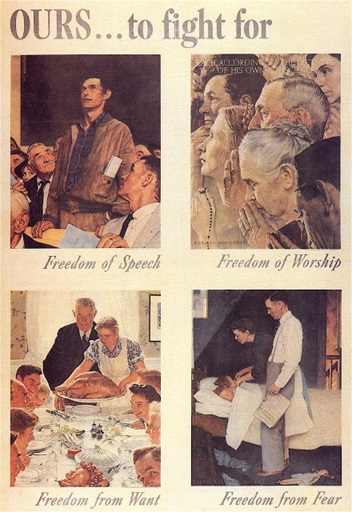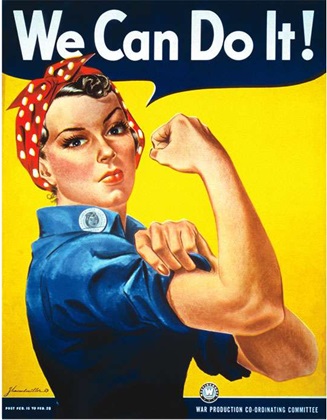|
     
The Impact of World War II
Popular Culture in WWII America
[Mr
Lads]
|
|
|
The War took over popular culture in America to such an extent, and with such lasting impact, that it is easy to forget that America's war lasted only three years, 1942-45.
During that time, most of America's popular culture was
controlled by the Office of War Information, formed in June 1942. Due to
clever presentation, even though propaganda, the productions it oversaw became
extremely popular.
|
Going Deeper
The following links will help you widen your knowledge:
A collection of
Primary Sources
 Axis Sally: World War II traitor who broadcast for the Nazis - BBC Witness History Axis Sally: World War II traitor who broadcast for the Nazis - BBC Witness History
|
Movies
The government’s Bureau of Motion Pictures (BMP) worked with Hollywood’s War Activities Committee (WAC) – both formed in 1941 – to censor and produce films which would help the war effort. The BMP head, Robert Riskin, believed that American movies – hitherto full of
gangsters and the wild west – needed to change to present an image of an America
worth fighting for. Films always started with newsreels (heavy-censored – e.g.
no footage was shown of Pearl Habor for a year) = an opportunity for
propaganda.
Hollywood turned out
movies set in the war (e.g.
Atlantic Convoy
(1942)/ Guadalcanal Diary
(1943), or about civilians caught up in it (such as
Casablanca,
1942).
Some films were explicit propaganda: e.g. Frank Capra’s series
Why We Fight.
Some were documentaries – e.g. John Ford's
The Battle of Midway (1942) / William Wyler’s
Memphis Belle
(1944).
The Three Stooges
lampooned the Nazis (e.g.
You Nazty Spy!,
1940).
The Warner brothers, committed anti-fascists, released the
Private Snafu cartoons, which humorously
encouraged service personnel about staying alert, taking care, security, proper sanitation habits, booby traps
etc.. Walt Disney’s
Out of the Frying Pan
starred Minnie Mouse as a housewife who saved bacon grease for the war
effort.
The
Tom and Jerry
cartoons date from 1942.
The Hollywood Victory
Committee organized 7,700 public events featuring 4,147 promoting war bond
sales, scrap collection, and military recruitment, plus shows to boost troop
morale .
|

Norman Rockwell's four artworks portrayed visually President
Roosevelt's 'Four Freedoms' speech of 1941 - ideas eventually incorporated into
the Charter of the United Nations.
|
Radio
Radio shows brought the war
home to the American people, with full days’ broadcasts of major events.
It’s Maritime,
Wings to Victory,
The Man Behind the Gun and
The Doctor Fights
were programs dramatizing the experiences of the Navy, Air Force, Army and
Medical Corps.
United Press sponsored
Soldiers of the Press detailing the experiences of their front-line correspondents
Dick Tracy was a children’s radio detective adventure program; listeners were encouraged to take a pledge vowing to "to save water, gas and electricity; to save fuel oil and coal; to save my clothes; to save Mom's furniture; to save my playthings."
Comedy programmes such as
The Jack Benny Show were used to build up support and morale. Sometimes whole episodes of the comedy show
Fibber McGee and Molly
were devoted to an OWI message about such as saving gas, meat rationing or
buying war bonds.
The Armed Forces Radio
Service (AFRS) broadcast light entertainment to the troops, including
servicemen’s requests.
Some US servicemen tuned in to listen to
Axis Sally and
Tokyo Rose
– German and Japanese English-language radio programmes which tried to
undermine US morale.
|
|
Literature
The Writer’s War Board, funded
by the OWI, created pro-American, anti-fascist propaganda. In 1942 the WWB, asked to help a recruitment drive, created 52 nonfiction articles, 12 fictional stories, a novel, and a song:
I Wanna Marry a Bombardier … which was so successful it had to be
withdrawn.
Authors like John
Steinbeck and Ernest Hemingway set their stories in war-torn Europe.
Bill Mauldin – a decorated US infantryman – showed the real side of military life through his cartoons of
Willie and Joe for the soldiers’ newspaper, Stars & Stripes;
when General Patton threatened to throw him in jail, General Eisenhower
overruled him; it was a soldiers’ paper.
In 1943 The Council on
Books in Wartime launched its Armed Services reprints of popular books and
sold over 122 million copies to the military at an average cost of about six
cents each.
Comic books were not
OWI-controlled, but heroes like Superman caught the national mood, fighting
the Axis powers on the front whilst supporting rationing and victory gardens
at home.
|
Art & Fashion
Much of the popular art of the
war depicted the soldier as hero.
-
Rockwell's art depicted a
romantic image of an America worth fighting for.
-
Powerful posters promoted war
bonds, scrap drives and rationing.
‘Rosie the Riveter’ –
originally coined in a
1942 song – became a cultural icon, glamorising/celebrating the role women in the war industries.
Women's fashions changed to include ‘utility clothing’ which saved on
material, and practical clothes such as one-piece ‘siren suits’, and
washable cottons pinafore dresses that could be worn with different cotton
blouses or sweaters for different looks.
|

Rosie the Riveter - the original poster by J Howard Miller (1942)
|
Dance & Music
These were the days of Jazz (e.g. Duke Ellington, Benny Goodman and Ella Fitzgerald), ‘Swing’ and ‘Boogie Woogie’ – e.g. the Andrews Sisters’
Boogie Woogie Bugle Boy.
People
Jived and Jitterbugged
to Glenn Miller’s 50-piece Army Air Force Band.
Frank Sinatra, Perry Como and were popular ‘crooners’, and Bing Crosby’s
White Christmas
idealised what the nation was fighting for.
During the war the United
Service Organisations (USO) put on more than a quarter of a million
performances in the United States and abroad, featuring celebrities of the
time.
|
Stopped, abandoned or
curtailed
Meanwhile, a number of
previously popular events stopped or were curtailed:
Local fairs, parades, festivals, circuses and carnivals were
scaled down – many were cancelled altogether. Baseball continued at the express request of Roosevelt – the place of men called up was taken by disabled and older players; the National Baseball League played 61 of its games on military bases raising $2million. To fill out the reduced fixtures, the
All-American Girls Professional Baseball League was founded in 1943 by Philip K.
Wrigley, the gum magnate and Chicago Cubs owner.
American Football also
continued at a reduced level; a new rule of free substitutions took account
of the fact that the players who had replaced men called up had reduced
fitness levels.
|
Consider:
1. Is propaganda evil? Is there a difference
between 'good' and 'bad' propaganda ... or is it just a case of 'our' propganda
versus 'theirs'?
2. "A lasting impact". Go through this page
and find examples of WWII popular culture which still are present in
our popular culture today.
- AQA Exam-style
Questions
5. How were the lives of Americans affected by WWII?
6. Which of the following was the more important reason
American women's lives improved during WWII:
•
economic reasons
• social and cultural reasons?
|
    
|

